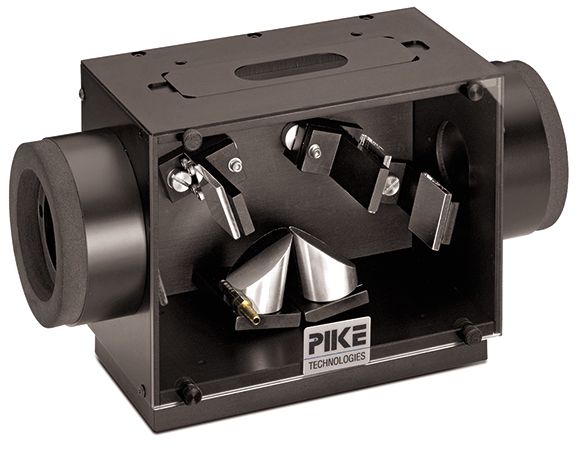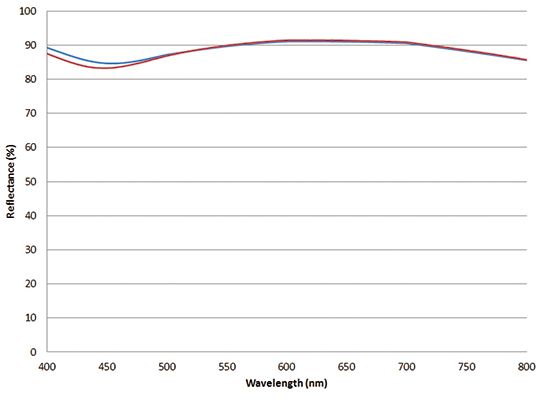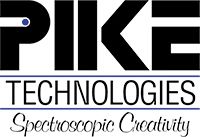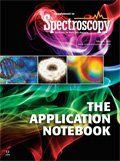Predictive Modeling of SiO2 Film Thickness on Aluminum
Application Notebook
Reflectivity of a thin layer of SiO2 applied to Al-coated glass was measured using the 10Spec, a near-normal specular reflection accessory. The reflection spectrum served as input data for FilmStar™ software to calculate SiO2 thickness.
Many applications in the optics industry require highly reflective surfaces to maintain laser intensity throughout the beam path. Aluminum is an optimal material in the visible spectrum (400–800 nm) for these applications. However, due to the softness of Al, proper maintenance of the surface requires an abrasion-resistant overcoat to allow for periodic cleaning of the optical surface.
SiO2 can protect Al while retaining a reflective surface. Previous work indicates SiO2 provides a barrier against abrasion (1,2). Based on testing outlined in MIL-C-48497, a minimum thickness of 200 nm is recommended.
Experimental Conditions
At the PIKE Technologies facility (Madison, WI), Al-coated glass substrate was pre-cleaned via ion assist with Ar gas for 10 min at a chamber pressure of approximately 1x10-4 Torr. Immediately following the Ar pre-cleaning, a thin SiO2 film was deposited onto the substrate at approximately 200 °C via electron beam physical vapor deposition.
Specular reflectance of the sample was measured between 400–800 nm using the 10Spec specular reflection accessory (PIKE Technologies, Madison, WI) in a research-grade spectrophotometer. The accessory has a 10 degree fixed angle of incidence (Figure 1). Its optics condition a focused beam into a collimated beam, creating a uniform 10 degrees striking the sample. All reflective optics allow spectral measurements from the UV to the far IR.

Figure 1: 10Spec near-normal specular reflection accessory.
FilmStar software (Princeton, NJ) was used to model the reflectance of SiO2 over the visible region. To maximize the optical properties of the coating, FilmStar's index-solving algorithm along with additional optimization features were used to model an ideal protective coating over Al assuming the refractive index of SiO2 to be n = 1.46 at 550 nm.
Results
The SiO2 coating exhibited uniform measured reflectance over the wavelength range (Figure 2). Using the visible reflection spectrum in conjunction with FilmStar's damped least squares optimization feature, the coating thickness was determined to be 220 nm (3). When compared to the FilmStar model, the reflectivity of our SiO2 coating is very similar. The modeled reflectance in FilmStar is fairly uniform over the wavelength range and greater than 83%, which is acceptable for most applications. A small discrepancy can be seen at approximately 450 nm due to a slightly different absorption, or k-value, utilized by FilmStar.

Figure 2: Reflectivity of the FilmStar modeled SiO2 coating (blue) and the measured visible spectrum from the deposited SiO2 coating on an Al-coated glass substrate (red).
Conclusion
The 10Spec specular reflection accessory is used to make near-normal measurements. Spectra obtained may be used as input and verification data for FilmStar and other optical measurement modeling software.
References
(1) U. Schulz, S. Jakobs, and N. Kaiser, Proc. SPIE2776, 169–174 (1996).
(2) M. Mazur, D. Wojcieszak, J. Domaradzki, D. Kaczmarek, S. Song, and F. Placido, Opto-Elec. Rev.21(2), 233–238 (2013).
(3) F. Goldstein, Proc. SPIE 7101, 710105 (2008).

PIKE Technologies
6125 Cottonwood Drive, Madison, WI 53719
tel. (608) 274-2721, fax (608) 274-0103
Website: www.piketech.com
